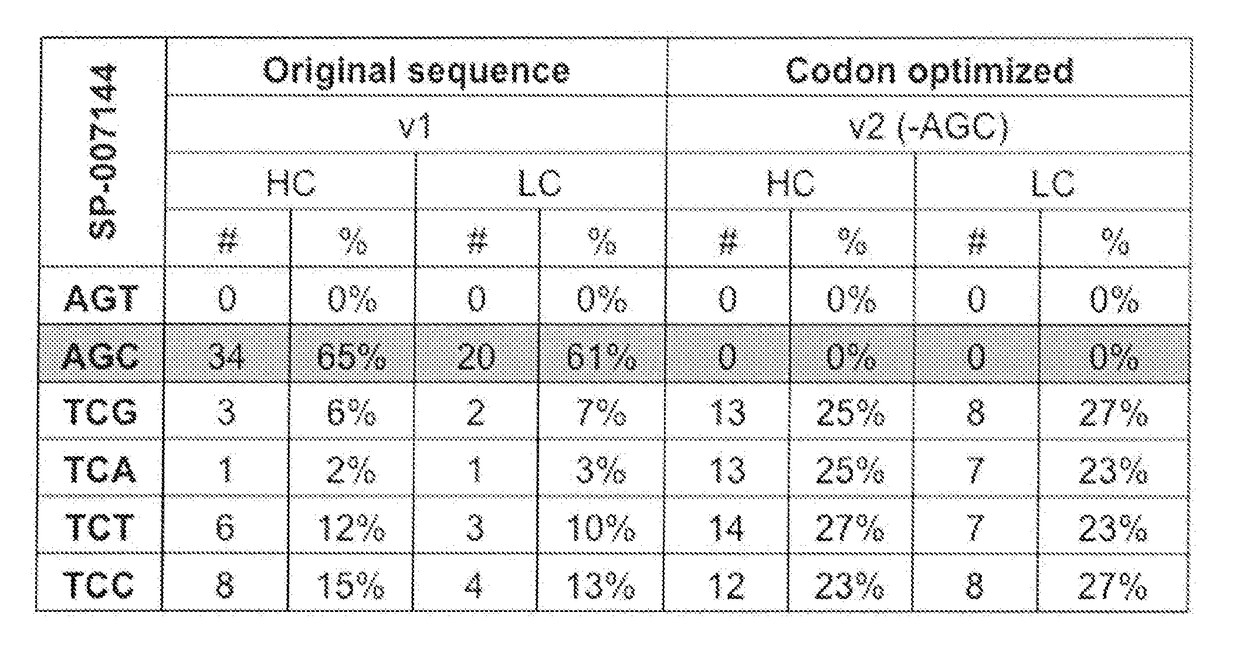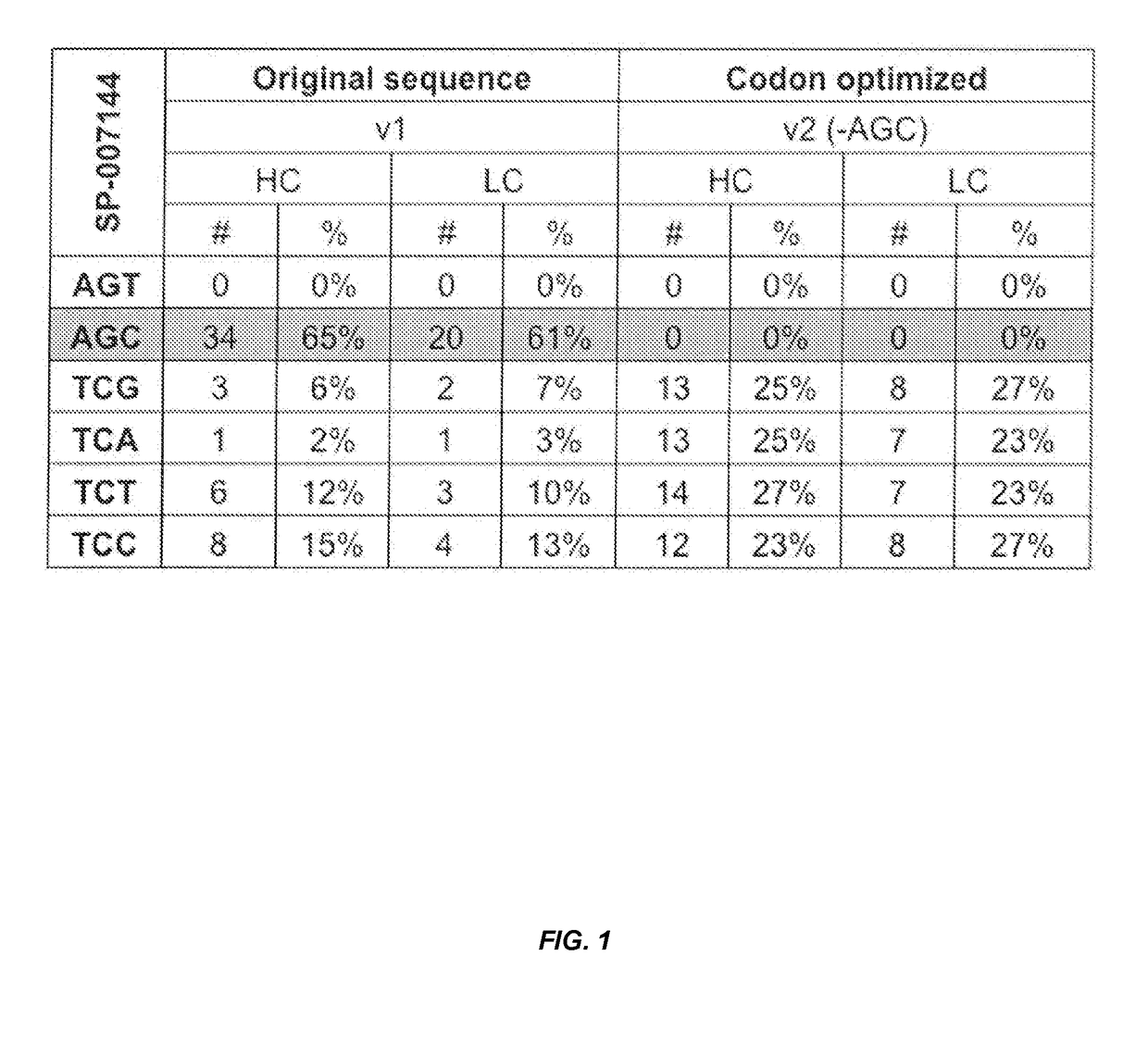Codon optimization for titer and fidelity improvement
a titer and fidelity improvement technology, applied in the field of codon optimization for titer and fidelity improvement, can solve the problems of increased amino acid misincorporation during translat, potentially causing deleterious immune responses, abnormal protein-protein interac, etc., and the methods for removing misincorporated proteins have proved to be difficul
- Summary
- Abstract
- Description
- Claims
- Application Information
AI Technical Summary
Benefits of technology
Problems solved by technology
Method used
Image
Examples
example 1
g Serine Codon Optimized Antibody Heavy Chain (HC) and Light Chain (LC) Nucleic Acid Templates for an Anti-CD74 Antibody
[0115]Codon usage analysis showed that greater than 60% of serine codons in the nucleic acid encoding an anti-CD74 heavy chain or light chain were AGC. The AGC codon can potentially causes serine to asparagine (S to N) substitutions due to a G / U mismatch at the second base pair of the codon. To eliminate such an amino acid substitution, the wild-type template was modified to replace all the AGC codons and evenly distribute other serine codons, such as TCG, TCA, TCT and TCC (FIG. 1). Thus, the serine optimized template encoding the anti-CD74 heavy and light chain contained no AGT (rare codon) and AGC codons, and about 25% (e.g., about 23-27%) of each of the TCG, TCA, TCT and TCC codons.
[0116]Wild-type genes (DNA) coding for anti-CD74 heavy chain and light chain (“original sequence” or “v1”) and serine codon optimized heavy chain and light chain (“optimized sequence”...
example 2
Protein Synthesis for Producing Antibodies with Codon Optimized Serines
[0119]The nucleic acid templates encoding the anti-CD74 heavy chain and light chain as described in Example 1 were used in cell free protein synthesis to produce full-length IgG. The nucleic acid templates were co-expressed in the presence of disulfide isomerase chaperones DsbC or PDI. The added chaperones can facilitate the formation of disulfide bonds and promote proper folding and antibody assembly.
[0120]Briefly, the cell free protein synthesis reaction as described in Zawada et al., 2011, Biotechnol. Bioeng. 108(7): 1570-1578 was performed with the following modifications. The cell-free extracts were prepared from an OmpT sensitive RF-1 attenuated strain that was also engineered to overexpress E. coli DsbC, and a similar RF-1 attenuated E. coli strain. The cell-free extracts were, treated with 50 μM iodoacetamide for 30 min at RT (20° C.), and then added to a premix containing all other components of a cell-f...
example 4
g Serine Codon Optimized Genes (Nucleic Acid Templates) Encoding the Trastuzamab Heavy Chain (HC) and Light Chain (LC)
[0130]The wild-type amino acid sequences of the trastuzumab heavy chain and light chain are set forth, for example, in ChEMBL Accession No. CHEMBL1201585. Wild-type genes (DNA) coding for the trastuzumab heavy chain and light chain (“original sequence” or “v1”) and serine codon optimized heavy chain and light chain (“optimized sequence” or “v2”) gene were synthesized (DNA 2.0, Menlo Park, Calif.). The only difference between v1 and v2 is serine codon usage.
[0131]The wild-type trastuzumab heavy chain nucleic acid template contained 35 AGC codons (about 77% of the total serine codons were AGC), 4 TCG codons, 5 TCT codons, 6 TCC codons and no AGT or TCA codons. The wild-type trastuzumab light chain nucleic acid template had 23 AGC codons, 2 TCG codons, 3 TCT codons, 3 TCC codons and no AGT or TCA codons.
[0132]In contrast, the codon optimized trastuzumab heavy chain gene...
PUM
| Property | Measurement | Unit |
|---|---|---|
| concentration | aaaaa | aaaaa |
| concentration | aaaaa | aaaaa |
| concentration | aaaaa | aaaaa |
Abstract
Description
Claims
Application Information
 Login to View More
Login to View More - R&D
- Intellectual Property
- Life Sciences
- Materials
- Tech Scout
- Unparalleled Data Quality
- Higher Quality Content
- 60% Fewer Hallucinations
Browse by: Latest US Patents, China's latest patents, Technical Efficacy Thesaurus, Application Domain, Technology Topic, Popular Technical Reports.
© 2025 PatSnap. All rights reserved.Legal|Privacy policy|Modern Slavery Act Transparency Statement|Sitemap|About US| Contact US: help@patsnap.com



